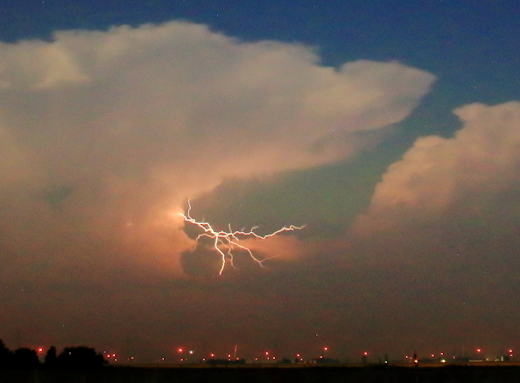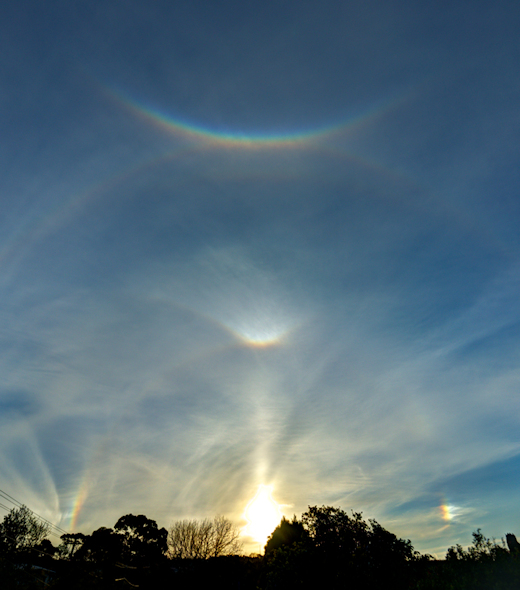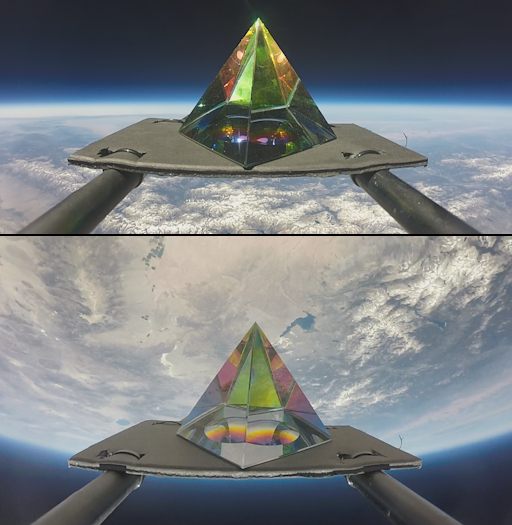Lights Over Lapland has a brand-new website full of exciting adventures in Abisko National Park, Sweden! Take a look at our aurora activities and book your once-in-a-lifetime trip with us today! | | |
SOLAR MINIMUM CONDITIONS ARE IN EFFECT: The sun is spotless again. For the 133rd day this year, the face of the sun is blank.To find a year with fewer sunspots, you have to go back to 2009 when the sun was experiencing the deepest solar minimum in a century. Solar minimum has returned, bringing extra cosmic rays, long-lasting holes in the sun's atmosphere, and strangely pink auroras. Free: Aurora Alerts.
LIGHTNING AND AURORAS: You don't see this every day--at least, not in Indiana. On Sunday morning, Aug. 26th, Hongming Zheng trained his camera on an electrical storm passing through West Lafayette. Just as a lightning bolt jumped across a gap in the clouds, a patch of green appeared in the background:

"It was the aurora borealis," says Zheng. "I took the picture around 3:33am as an unexpected geomagnetic storm brought Northern Lights down to Indiana--a rare sight at 40°N. Unfortunately, a full moon washed out most of the aurora. Otherwise it would have been a spectacular green and red glow against a black sky."
The geomagnetic storm started on Aug. 25th when a coronal mass ejection (CME) hit Earth's magnetic field, opening a crack in our planet's magnetosphere. Solar wind poured in to fuel auroras seen from the Arctic Circle to Indiana. Not bad for solar minimum.
Realtime Aurora Photo Gallery
RARE ICE HALOS OVER SYDNEY: Today something unusual happened in the sky above Sydney, Australia. The rising sun was preceded by a network of luminous curls, circles and arches. "It was a very rare display," says Adriano Massatani who photographed the sunrise:

These luminous forms are called ice halos, because they caused by sunlight shining through icy crystals in cirrus clouds. Usually ice halos are simple, like a solitary pillar or an uncomplicated ring. In this case, however, a complex assortment of halos criss-crossed the sky. In Massatani's photo, we see a circumzenithal arc, an upper tangent arc, an upper suncave Parry arc, a 22-degree halo, a 46 degree halo, a supralateral arc, and a pair of sundogs.
That's not all. "Later, I also saw a complete parhelic circle--something I have been hoping to see for years," says Massatani.
The variety of halos Massatani witnessed was caused by a corresponding
variety of ice crystals with rare
gem-like perfection and unusually precise crystal-to-crystal alignment. What are the odds? No one knows. Certainly, though, it was a lucky day in Sydney.
Realtime Space Weather Photo Gallery
IRIDESCENT SPACE PYRAMID: Spaceweather.com and the students of Earth to Sky Calculus have been traveling around the world launching cosmic ray balloons to map Earth's radiation field. This runs up a big helium bill. To help pay it, we sent this iridescent crystal pyramid to the stratosphere:

You can have it for $149.95. The students are selling this pyramid and several others like it to fund the Earth to Sky ballooning program. Each one comes with a greeting card showing the pyramid in flight and telling the story of its journey to the edge of space. All sales support hands-on STEM research.
Far Out Gifts: Earth to Sky Store
All sales support hands-on STEM education
Realtime NLC Photo Gallery
Every night, a network of
NASA all-sky cameras scans the skies above the United States for meteoritic fireballs. Automated software maintained by NASA's Meteoroid Environment Office calculates their orbits, velocity, penetration depth in Earth's atmosphere and many other characteristics. Daily results are presented here on Spaceweather.com.
On Aug. 30, 2018, the network reported 18 fireballs.
(18 sporadics)

In this diagram of the inner solar system, all of the fireball orbits intersect at a single point--Earth. The orbits are color-coded by velocity, from slow (red) to fast (blue). [Larger image] [movies]
Potentially Hazardous Asteroids (
PHAs) are space rocks larger than approximately 100m that can come closer to Earth than 0.05 AU. None of the known PHAs is on a collision course with our planet, although astronomers are finding
new ones all the time.
On August 30, 2018 there were 1912 potentially hazardous asteroids.
 |
Recent & Upcoming Earth-asteroid encounters: | Asteroid | Date(UT) | Miss Distance | Velocity (km/s) | Diameter (m) |
| 2018 QH1 | 2018-Aug-27 | 13.2 LD | 12.5 | 27 |
| 2018 LQ2 | 2018-Aug-27 | 9.4 LD | 1.5 | 39 |
| 2016 GK135 | 2018-Aug-28 | 16.8 LD | 2.8 | 9 |
| 2016 NF23 | 2018-Aug-29 | 13.2 LD | 9 | 93 |
| 1998 SD9 | 2018-Aug-29 | 4.2 LD | 10.7 | 51 |
| 2018 DE1 | 2018-Aug-30 | 15.2 LD | 6.5 | 28 |
| 2001 RQ17 | 2018-Sep-02 | 19.3 LD | 8.3 | 107 |
| 2015 FP118 | 2018-Sep-03 | 12.3 LD | 9.8 | 490 |
| 2018 QA | 2018-Sep-03 | 17.5 LD | 20.4 | 73 |
| 2017 SL16 | 2018-Sep-20 | 8.5 LD | 6.4 | 25 |
| 2018 EB | 2018-Oct-07 | 15.5 LD | 15.1 | 155 |
| 2014 US7 | 2018-Oct-17 | 3.2 LD | 8.7 | 19 |
| 2013 UG1 | 2018-Oct-18 | 10.4 LD | 13.4 | 123 |
| 2016 GC221 | 2018-Oct-18 | 8.7 LD | 14.4 | 39 |
Notes: LD means "Lunar Distance." 1 LD = 384,401 km, the distance between Earth and the Moon. 1 LD also equals 0.00256 AU. MAG is the visual magnitude of the asteroid on the date of closest approach. | | Cosmic Rays in the Atmosphere |
SPACE WEATHER BALLOON DATA: Approximately once a week, Spaceweather.com and the students of Earth to Sky Calculus fly space weather balloons to the stratosphere over California. These balloons are equipped with radiation sensors that detect cosmic rays, a surprisingly "down to Earth" form of space weather. Cosmic rays can seed clouds, trigger lightning, and penetrate commercial airplanes. Furthermore, there are studies ( #1, #2, #3, #4) linking cosmic rays with cardiac arrhythmias and sudden cardiac death in the general population. Our latest measurements show that cosmic rays are intensifying, with an increase of more than 18% since 2015:

The data points in the graph above correspond to the peak of the Reneger-Pfotzer maximum, which lies about 67,000 feet above central California. When cosmic rays crash into Earth's atmosphere, they produce a spray of secondary particles that is most intense at the entrance to the stratosphere. Physicists Eric Reneger and Georg Pfotzer discovered the maximum using balloons in the 1930s and it is what we are measuring today.
En route to the stratosphere, our sensors also pass through aviation altitudes:

In this plot, dose rates are expessed as multiples of sea level. For instance, we see that boarding a plane that flies at 25,000 feet exposes passengers to dose rates ~10x higher than sea level. At 40,000 feet, the multiplier is closer to 50x.
The radiation sensors onboard our helium balloons detect X-rays and gamma-rays in the energy range 10 keV to 20 MeV. These energies span the range of medical X-ray machines and airport security scanners.
Why are cosmic rays intensifying? The main reason is the sun. Solar storm clouds such as coronal mass ejections (CMEs) sweep aside cosmic rays when they pass by Earth. During Solar Maximum, CMEs are abundant and cosmic rays are held at bay. Now, however, the solar cycle is swinging toward Solar Minimum, allowing cosmic rays to return. Another reason could be the weakening of Earth's magnetic field, which helps protect us from deep-space radiation.
| | The official U.S. government space weather bureau |
| | The first place to look for information about sundogs, pillars, rainbows and related phenomena. |
| | Researchers call it a "Hubble for the sun." SDO is the most advanced solar observatory ever. |
| | 3D views of the sun from NASA's Solar and Terrestrial Relations Observatory |
| | Realtime and archival images of the Sun from SOHO. |
| | from the NOAA Space Environment Center |
| | fun to read, but should be taken with a grain of salt! Forecasts looking ahead more than a few days are often wrong. |
| | from the NOAA Space Environment Center |
| | the underlying science of space weather |
 | If you are a Youtuber and want to buy real Youtube views than try out Buyrealsocial.com for the best results possible! |
 | To find reviews of new online casino sites in the UK try The Casino DB where there are hundreds of online casino reviews complete with bonuses and ratings. |
| | These links help Spaceweather.com stay online. Thank you to our supporters! |
| | | | | | |

